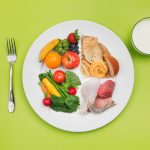

Make the grocery store less confusing for your clients. As you know, there are many misconceptions about what is and isn’t healthy. Food marketers make it ever more confusing with false and exaggerated claims about their products.
Nutrition starts in the cart and happens when you’re not there to observe choices.
While most of us are not registered dietitians and may not be giving clients specific meal plans, I believe it is within our scope of practice as personal trainers to educate our clients about making healthy choices in the grocery store.
Here’s how…
# 1 Shop the Perimeter (for the most part) – Most of the whole and unprocessed foods are around the perimeter of the store. Here you’ll find foods such as fruits and vegetables, poultry, beef, dairy, and fish. Usually, unprocessed foods without preservatives need refrigeration which is why most of them are around the perimeters.
Don’t lead your clients to think they can never venture into the middle aisles because there they will find some healthy whole grains like brown rice and oatmeal. Also, the middle aisles are where they will find deodorant and you definitely want them to use that if they are exercising with you. : )
# 2 Nutrition Labels – The FDA recently updated their nutritional label requirements. This will help your clients make more informed choices. Some of the most important changes to teach your clients about are:
- Bold type is now being used to list the serving size. This helps your clients to better understand how many servings are in the package so they don’t overeat and can accurately gauge their caloric intake.
- The amount of added sugar to the product is now on the label. Previously, the label would show the amount of total sugar but now our clients can see how much of that sugar is from the actual food and how much the food companies add to improve the taste. The big problem with sugar isn’t so much the natural sugars from real fruits, it’s all the added sugar.
#3 Deciphering Label Claims – Food marketers use a lot of really great and healthy sounding words on food packages and most of our clients don’t know what they truly mean. While someone may feel good buying a product that says “Natural” on it, they will be surprised to learn that it mostly likely doesn’t mean what they think it means. Here are a few of the most common label claims and what they actually mean:
Natural-There is no system in place to verify “Natural” claims; this is essentially a meaningless claim. For example, meats labeled “Natural” can come from animals fed diets other than their natural diets, given hormones or antibiotics, and be factory farmed.
Cage Free – There is no legal definition for the term. Cage free hens are often in large barns crammed in with so many others they are unable to engage in natural behaviors such as spreading their wings, pecking, and nesting.
Pastured – Animals that are pastured have open pastures to roam and graze on their normal diet of grass. They live the majority of their lives outdoors and the meat, eggs, and dairy from pasture raised animals are healthier options.
Organic – The USDA National Organic Program (NOP) defines organic as follows:“Organic food is produced by farmers who emphasize the use of renewable resources and the conservation of soil and water to enhance environmental quality for future generations.
Organic meat, poultry, eggs, and dairy products come from animals that are given no antibiotics or growth hormones. Organic food is produced without using most conventional pesticides; fertilizers made with synthetic ingredients or sewage sludge; bioengineering; or ionizing radiation.
Before a product can be labeled “organic,” a Government-approved certifier inspects the farm where the food is grown to make sure the farmer is following all the rules necessary to meet USDA organic standards. Companies that handle or process organic food before it gets to your local supermarket or restaurant must be certified, too.”
Wild Caught – Wild caught fish were caught in their natural habitat (ocean, river, lakes, etc) and not raised in tanks. Wild caught is a healthier option than fish raised in tanks. Fish that are raised on farms are often fed antibiotics to prevent disease due to unsanitary conditions and artificial colors to mimic the color of their meat based on their natural feeding habits.
Vegetarian Fed –This means the chickens weren’t fed any animal byproducts; however, chickens are omnivores and eat worms and bugs, so this label means the chickens did not eat their natural diet.
Grass Fed vs Grass Finished – For a meat or dairy product be labeled as grass fed the animal must have spent the majority of its life eating grass (its natural diet). Grass fed animals can still be “finished” on grains, corn, soy, etc to fatten the animal up in its final weeks. While this is a better choice than conventional grain fed cows, it is not as optimal as Grass Finished. These animals eat grass for 100% of their lives and their meat is the healthiest.
#4 Dirty Dozen/Clean Fifteen – Every year the Environmental Working Group releases a list of produce that are most contaminated with pesticides and chemicals as well as the least contaminated foods. This can serve as a guide to know when it’s more important to buy organic and when it is acceptable to buy conventional produce. The guide can also be helpful when your clients are working within a budget, enabling them to determine what foods they can buy conventional to save money.
#5 Have a Plan – It is easy to walk out of the grocery store with a cart full of food that isn’t on your nutrition plan if you don’t make a list and stick to it. To make food shopping easier for your clients try putting together a checklist of healthy foods broken down by proteins, starchy carbs, fats, fruits, and veggies that they can bring to the store. Not only will the checklist help your clients shop healthier it also shows them that you go above and beyond for your clients.
#6 Read the Ingredients, Not just the Nutrition Label – When it comes to shopping healthy the nutrition facts are only half the battle. The ingredients list is just as important and will tell you what is actually in the product. There is a great NFPT CEC article HERE to learn more about what ingredients to advise your clients to look for.
#7 Use an App – There are a variety of smartphone apps that can help your clients with their grocery shopping. The one I recommend most is called Fooducate, this app provides a variety of useful information about a product when you scan the barcode. This will definitely help your clients make more informed and better choices.
Talking with our clients about strategies to grocery shop healthier or even going with them to the grocery store will help them learn how to best navigate the aisles and make healthier choices. This is a win for you as their trainer because eating healthy is a very large part of helping people reach their fitness goals.
[info type=”facebook”]What are your best tips for healthy grocery shopping? Let us know in the Facebook Community Group if you’re NFPT certified. If you’re not, come chat with us here![/info]






